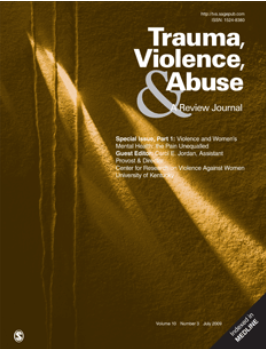Instruments to Assess Bidirectional Intimate Partner Violence: A Systematic Review
IF 5.4
1区 社会学
Q1 CRIMINOLOGY & PENOLOGY
引用次数: 0
Abstract
Intimate partner violence (IPV) is a significant public health issue that affects individuals, families, and society in profound ways. Over the years, research has often shown that such IPV is predominantly one-sided, with men as perpetrators and women as victims. However, more recent studies have revealed that IPV is frequently bidirectional, with both partners potentially being victims, perpetrators, or both. Despite this growing awareness, little is known about the tools used to assess bidirectional violence (BV). This systematic review aims to synthesize the published scientific literature on the instruments used to assess bidirectional IPV among adult men and women. Following Preferred Reporting Items for Systematic Reviews and Meta-Analyses (PRISMA) guidelines, a search was conducted across databases such as PubMed, B-on, Web of Science, and Scielo. Fifty studies published between 2012 and 2024 met the inclusion criteria. Most of the studies were conducted with community samples recruited through online questionnaires. The Conflict Tactics Scale emerged as the most used instrument for evaluating BV, demonstrating robust psychometric properties. BV prevalence rates ranged from 2% to 98.4% and remained generally consistent across different instruments, except in the case of male reports. However, the limited number of studies on interpartner agreements and the reliance on single-partner self-reports pose challenges to the accuracy of these estimates. While this systematic review provides a comprehensive overview of the instruments used to assess BV, it underscores the need for future research to develop more precise, context-sensitive tools, that incorporate reports from both partners to improve the accuracy of BV assessment.评估双向亲密伴侣暴力的工具:系统回顾
亲密伴侣暴力(IPV)是一个重大的公共卫生问题,对个人、家庭和社会产生深远影响。多年来,研究经常表明,这种IPV主要是单方面的,男性是肇事者,女性是受害者。然而,最近的研究表明,IPV通常是双向的,双方都可能是受害者或加害者,或者两者兼而有之。尽管这种意识日益增强,但人们对评估双向暴力的工具知之甚少。本系统综述旨在综合已发表的用于评估成年男性和女性双向IPV的仪器的科学文献。根据系统评价和荟萃分析的首选报告项目(PRISMA)指南,在PubMed、B-on、Web of Science和Scielo等数据库中进行了搜索。2012年至2024年间发表的50项研究符合纳入标准。大多数研究都是通过在线问卷收集社区样本进行的。冲突战术量表是最常用的评估心理行为的工具,显示出强大的心理测量特性。除了男性报告外,BV患病率从2%到98.4%不等,在不同的工具中基本保持一致。但是,关于伙伴间协定的研究数量有限,而且依赖于单一伙伴的自我报告,这对这些估计的准确性构成了挑战。虽然这一系统审查提供了用于评估细菌性疾病的工具的全面概述,但它强调了未来的研究需要开发更精确的、对环境敏感的工具,这些工具将纳入双方合作伙伴的报告,以提高细菌性疾病评估的准确性。
本文章由计算机程序翻译,如有差异,请以英文原文为准。
求助全文
约1分钟内获得全文
求助全文
来源期刊

Trauma Violence & Abuse
Multiple-
CiteScore
13.60
自引率
7.80%
发文量
131
期刊介绍:
Trauma, Violence, & Abuse is devoted to organizing, synthesizing, and expanding knowledge on all force of trauma, abuse, and violence. This peer-reviewed journal is practitioner oriented and will publish only reviews of research, conceptual or theoretical articles, and law review articles. Trauma, Violence, & Abuse is dedicated to professionals and advanced students in clinical training who work with any form of trauma, abuse, and violence. It is intended to compile knowledge that clearly affects practice, policy, and research.
 求助内容:
求助内容: 应助结果提醒方式:
应助结果提醒方式:


